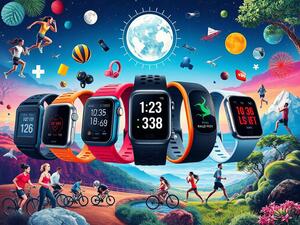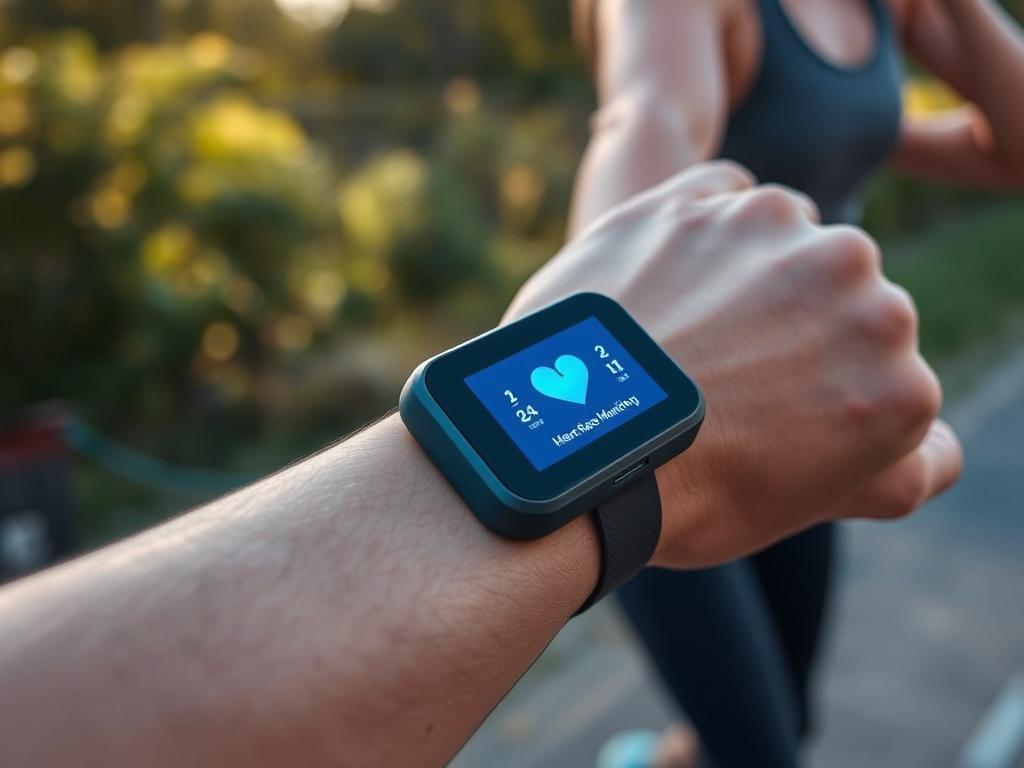When you put on your running shoes or start your yoga, you’re making a promise to get better. Technology is there with you, tracking your heartbeats and steps. It cheers for every victory you win.
Wearable fitness bands are key for a better life. The Garmin fenix 8 Solar Sapphire and COROS Pace 3 are top picks. They have cool features for all fitness levels.
Starting your day with insights from your wrist is exciting. Devices like the Amazfit GTR 4 and Garmin Venu Sq 2 last for days or weeks. They help you reach your goals with new tech.

The Garmin Fenix series is tough and lasts up to 37 days with solar charging. The Apple Watch Ultra and COROS Pace 3 are also great choices. They offer top performance without costing too much.
The Fitbit Charge 6 is a reliable workout buddy for a week. It doesn’t need to be charged often.
These gadgets don’t just keep up; they help you go further. With the Garmin Forerunner 265 and Apple Watch Series 10, you feel empowered. Each step and heartbeat is tracked and celebrated.
Overview of Wearable Fitness Bands
Wearable fitness bands have changed how we watch our health. They are key tools for tracking our daily well-being. By 2025, new models like the Garmin Fenix 8 AMOLED and Oura Ring 4 will offer better accuracy and features.

Definition and Types of Wearable Fitness Bands
Wearable fitness bands are also called activity trackers or smartwatches. They track our physical activities and health. There are different types:
- Activity Trackers: Basic models that track steps, calories, and sleep.
- Smartwatches: Advanced devices like the Apple Watch Ultra that send notifications and track health.
- Sports Watches: Special watches from brands like Garmin for detailed sports data and training.
Key Features and Technologies
Wearable fitness bands have many features for health monitoring. They include:
- GPS Tracking: Important for outdoor activities, it shows location and routes.
- Heart Rate Sensors: They monitor heart rate, helping detect issues and improve workouts.
- Mobile Connectivity: They connect with phones for real-time data and alerts.
- VO2 Max Measurement: It shows the body’s oxygen use during hard exercise.
- Sleep Quality Analysis: It gives insights into sleep, helping keep us healthy.
Popular Brands and Models
Many brands are known for their wearable fitness bands. Each offers different models for various needs:
- Garmin: Models like the Garmin Forerunner 265 and Garmin Lily 2 Active are known for durability and tracking.
- Fitbit: The Fitbit Charge 6 is liked for its easy-to-use design and health data.
- Apple: The Apple Watch Ultra is known for its design and advanced technology.
These brands keep improving, introducing new models like the Amazfit T-Rex 3 and Polar Vantage M3. This growth is expected to reach about $114.36 billion by 2028, growing 15.4% each year.
In summary, wearable fitness bands are essential for health monitoring and improving our lifestyle. Their popularity and technology advancements promise a bright future.

History of Wearable Fitness Bands
The wearable industry history shows a big change in fitness tracking over 10 years. First, these devices just counted steps. Now, they track health in many ways. This shows how innovation and key moments have changed how we see health and fitness.

Evolution of Fitness Trackers
The start of fitness tracking was simple. In 1981, heart rate monitors for athletes came out. Then, in 1986, the RS-Computer shoe added tracking to shoes. By the early 2000s, these devices became common, with wireless heart rate monitors for gyms.
By 2010, apps let people share their fitness on social media. This was a big step forward.
Pioneering Companies in the Industry
Companies like Fitbit and Garmin changed fitness tracking a lot. Fitbit’s Fitbit Flex was a big hit, making fitness tracking popular. Garmin added cool features like solar charging and GPS.
Apple’s Apple Watch made technology more accessible to everyone. This helped more people use fitness trackers.
Milestones in Wearable Technology
Wearable tech has seen many important moments. In the early 2010s, devices like BodyMedia and Jawbone’s UP came out. They were for health and work.
By 2016, devices for kids were available, thanks to UNICEF and Garmin. Now, trackers can even monitor health without needing a hospital. This is a big step forward.
Today, devices can even find heart problems like atrial fibrillation. Studies show how these trackers affect people, like how they can help with obesity in teens. These moments show how the wearable fitness world keeps growing and changing.
Data Privacy and Wearable Fitness Bands
Wearable health technology is getting more popular. People want to track their health in real-time. This makes keeping personal health data safe very important.
Fitness trackers collect data like heart rates and sleep patterns. It’s vital to protect this data. This keeps users trusting the devices and stops identity theft.
Importance of Data Privacy in Health Tracking
Data privacy is key in health tracking. Wearable devices collect a lot of health data. This helps doctors diagnose and treat faster.
But, this data must be kept safe. Breaches can harm companies’ reputations and trust. In 2021, a breach exposed 61 million fitness tracker records.
Common Data Privacy Concerns
Wearable fitness bands raise many privacy concerns. Users are worried about who sees their data. For example, Fitbit was sued in 2011 for sharing health data without asking.
There’s also concern about laws like GDPR. They don’t fully protect personal health data. In Maryland, there’s a law to protect personal info, but it’s not enough for everyone.
Industry self-regulation is trying to help. But, we don’t know if it works yet. With more apps using wearable data, keeping it safe is more important than ever.
Principles of Data Encryption
Data privacy is very important today, more than ever. This is true, even in areas like secure health monitoring. Knowing about data encryption standards is key to keeping sensitive info safe from hackers.
Definition of Data Encryption
Data encryption turns plain text into coded messages. Only those with the right key can read it. This keeps data from wearable fitness bands safe and private.
Advanced algorithms scramble the data, making it unreadable without the decryption key. With over 25% of U.S. consumers using fitness apps, strong encryption is more critical than ever.
How Encryption Works
Encryption uses math to change data into a coded form. Standards like AES and RSA are used for this. They make sure only the right people can read the data again.
Health trackers have become very popular, from 20 million in 2014 to 120 million by 2019. This shows how vital it is to protect health data.

The Role of Digital Signatures & Verification
In the fast-changing world of wearable tech, keeping data safe and real is key. Digital signatures help make sure data from wearables is secure. With wearables for health checks growing fast, keeping data safe is more important than ever.
Importance of Digital Signatures
Digital signatures are vital for checking if data from wearables is real and hasn’t been changed. As more people want to use wearables for health checks, digital signatures help protect against fake data. They are important in many fields, like healthcare and industry, where wearables make things better.
How Digital Signatures Enhance Security
Digital signatures use public and private keys to check if data is from the right source and hasn’t been changed. This makes sure secure data transmission and helps people trust the wireless sharing of health data. Studies show digital signatures are very good at keeping data safe, with high accuracy and success in spotting fake data.
Also, new ways to check digital signatures could help fight financial fraud. This could make checks and contracts safer, helping many areas like law and elections.

Benefits of Encryption for Wearable Devices
Encryption is key for wearable devices. It keeps data safe and stops others from getting in. With more people using these devices for health and fitness, keeping data secure is very important.

Ensuring Data Integrity
Encryption keeps data safe and sound. It makes sure your info stays the same when stored or sent. This is very important.
Data breaches can cost a lot, almost $4.5 million. Wearable devices often use Bluetooth, which is not always secure. This shows why encryption is so important.
Prevention of Unauthorized Access and Data Breach
Encryption stops others from getting into your device. Data breaches can hurt businesses a lot. They often happen because of weak passwords.
Wearable devices don’t get updates as fast as other tech. But encryption can help a lot. It can cut down data breach risks by 60%.
Most healthcare groups see data security as a big deal. Encryption helps them follow rules. It also makes people more likely to share their health info.
Encryption can block up to 90% of ransomware attacks on health records. This shows how important it is for keeping devices safe and trustworthy.
Applications of Encryption in Fitness Technology
Wearable fitness tech has changed how we track our health. But, it raises big privacy concerns. Encryption apps are key in keeping our data safe.
Securing Personal Health Data
Keeping our health data safe is very important today. Encryption applications protect our personal info like activity logs and biometrics. They keep our data safe from hackers.
Studies show over 50% of users worry about their health data safety. Using encryption can make nearly 70% of wearable devices more secure. This is very important because these devices are not as strong as computers.
Protection during Data Transfers
When data moves from devices to other systems, it’s at risk. Health data safety during this time is critical. End-to-end encryption can cut down data tampering and interception risks by 80%.
Incidents like the 2018 MyFitnessPal breach and Strava’s security flaw show why we need strong encryption. It could save billions in costs from cyberattacks and identity theft.
Tools and Software for Encryption
Many tools and software help make wearable fitness bands secure. They use advanced encryption to keep data safe and private. Here are some top picks for encryption tools and secure ways to share files.
Recommended Encryption Tools
Here are some top encryption tools for strong software security:
- AxCrypt Premium: It costs $45 a year and works on Windows, macOS, Android, and iOS. It needs a free account for secure sharing.
- Folder Lock: It’s $39.99 on Amazon. It has file shredding, secure online backup, and can delete files securely.
- Xecrets Ez Premium: It’s $15.00 from Axantum Software. It encrypts, decrypts, edits, and shares files securely. It uses the same encryption as AxCrypt Premium.
- Advanced Encryption Package: It supports 17 encryption algorithms and works from the command line. It also has a password generator.
- EncryptionSafe: It has a free version and a Pro version that’s very affordable. The Pro version adds more features.
Overview of Secure File Sharing Options
Secure file sharing is key for software security with wearable fitness bands. Here are some safe ways to share files:
- Encrypted Cloud Services: Use Google Drive or Dropbox with encryption software. This keeps data safe during transfer and storage.
- Secure Email Services: Services like ProtonMail or StartMail are great for sharing sensitive info securely.
- VPN Services: VPNs like NordVPN or ExpressVPN create secure channels. They protect against unauthorized access.
Using these encryption tools and secure sharing options makes wearable fitness band data safe. It keeps privacy and integrity intact.
Step-by-Step Guide to Encrypting & Decrypting Messages
In today’s world, keeping your messages safe is key. This guide to data encryption will show you how to encrypt and decrypt messages. We’ll focus on ways to keep your data private.
Basic Encryption Techniques
There are two main ways to encrypt and decrypt messages. Symmetric encryption uses the same key for both. AES is a good example, with key sizes of 128, 192, or 256 bits.
Asymmetric encryption uses a public and private key pair. The public key encrypts, and the private key decrypts. This method is great for secure internet data exchanges.
Tools for Encryption and Decryption
Many software tools help with encrypting and decrypting data. GnuPG and OpenSSL are popular for their strong security. When encrypting on devices like fitness trackers, make sure the decryption software works with them.
Data from devices like Fitbit can help solve crimes. This shows how important it is to handle data securely.
In summary, knowing how to encrypt and decrypt data is vital. Using the right tools and techniques keeps your messages safe. Whether you use symmetric or asymmetric methods, learning these skills protects your data.
Comparisons of Encryption Standards
The world is getting more connected, with over 124 billion IoT devices expected by 2030. This means we need strong encryption to keep data safe. With over 68,000 medical devices at risk online, picking the right encryption is key.
Open PGP vs. Other Encryption Standards
Open PGP is a top choice for encryption because it’s widely used and secure. It’s great for keeping personal messages safe. But, it’s not the only game in town. SSL/TLS and AES have their own strengths.
- Open PGP: Best for secure emails and files, thanks to its public and private keys.
- SSL/TLS: Crucial for web security, used in browsers and online services.
- AES: Fast and efficient, used in many apps, including fitness trackers.
Comparison with SSL/TLS and AES
SSL/TLS and AES have their own roles in keeping data safe. SSL/TLS is key for web security, protecting data as it moves online. AES is fast and strong, perfect for keeping data safe in devices and apps.
Each encryption standard has its own job. SSL/TLS is vital for the internet, while AES is great for all kinds of data. Open PGP is top-notch for emails and files. Choosing the right one depends on what you need to protect.
Challenges and Limitations of Encryption
Encryption makes wearable fitness bands safer, protecting user data. But, it’s hard for non-tech-savvy users to use. They might find it hard to navigate the security features, making these devices less appealing.
Usability Issues for Non-Tech Savvy Users
Encryption can be tough for everyday people to handle. For example, Fitbit uses AES encryption, but users might not get how it keeps their data safe. Apple’s method of keeping data on the device is smart but can confuse those who don’t know about federated learning.
Garmin’s way of handling shared data also assumes users know a lot. This can lead to privacy settings being mishandled.
Balancing Security and User Experience
It’s important to find a balance between security and ease of use. Too much security can make devices hard to use. This might stop users from using all the features of their fitness trackers.
Brands need to make their devices easy to use while keeping them secure. In 2018, MyFitnessPal had a big data breach, showing the need for better security. Medtronic’s AI in its CGM systems is a good example of how to improve security without making things too complicated.
In short, encryption is key for keeping user data safe. But, it must be easy for users to understand and use. As the wearables market grows, solving these challenges is vital for gaining trust and more users.




